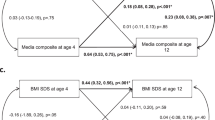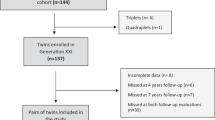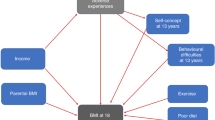Abstract
Objective:
This study examines the contribution of best friends’ weight and the peer social context (time spent alone versus with friends) as sources of unshared environment associated with variability in weight and health behaviors among weight-discordant siblings.
Methods:
Pairs of same-sex biologic siblings (N=40 pairs; ages 13–17) were originally recruited as part of a study evaluating putative factors contributing to differences in adiposity among weight-discordant siblings. Siblings were asked to bring their best friends to the laboratory and siblings and friends’ height and weight were objectively measured. Siblings also completed multi-pass dietary recalls to assess energy intake and sugar sweetened beverage (SSB) consumption. Siblings’ physical activity was measured using accelerometry. Experience sampling methodology was used to assess sedentary behaviors/screen time and the number of occasions siblings spent alone and in the presence of friends. Multilevel models were used to estimate the relationships between predictors (best friends’ zBMI, time spent alone or with friends) and outcomes (siblings’ zBMI and obesity-related health behaviors).
Results:
Best friends’ zBMI was the best predictor of participants’ zBMI, even when controlling for child’s birth weight. Best friends’ weight (zBMI) further predicted participants’ SSB intake and time engaged in sedentary behaviors. Being active with friends was positively associated with participants’ overall physical activity, whereas spending time alone was negatively associated with accelerometer counts regardless of siblings’ adiposity.
Conclusions:
A friends’ weight and the social context are unshared environmental factors associated with variability in adiposity among biologically-related weight-discordant siblings.
This is a preview of subscription content, access via your institution
Access options
Subscribe to this journal
Receive 12 print issues and online access
$259.00 per year
only $21.58 per issue
Buy this article
- Purchase on Springer Link
- Instant access to full article PDF
Prices may be subject to local taxes which are calculated during checkout

Similar content being viewed by others

References
Plomin R, Daniels D . Why are children in the same family so different from one another? Behavioral and Brain Sciences, 10, 1-16. Why are children in the same family so different from one another? Behav Brain Sci 1987; 10: 1–16.
Faith MS, Krall TVE . Social environmental and genetic influences on obesity and obesity-promoting behaviors: fostering research integration. In: Hernandez LM, Blazer DG (eds). Genes, Behavior, and the Social Environment. National Academies Press: Washington, DC, USA, 2006, pp 236–279.
Tripicchio GL, Keller KL, Johnson C, Pietrobelli A, Heo M, Faith MS . Differential maternal feeding practices, eating self-regulation, and adiposity in young twins. Pediatrics 2014; 134: e1399–e1404.
Keller KL, Pietrobelli A, Johnson SL, Faith MS . Maternal restrictions of children's eating and encouragements to eat as the 'non-shared environment': a pilot study using the child feeding questionnaire. Int J Obes 2006; 30: 1670–1675.
Kral TV, Moore RH, Compher CW . Maternal concern about child weight in a study of weight-discordant siblings. Public Health Nurs 2015; 32: 132–142.
Roemmich JN, White TM, Paluch R, Epstein LH . Energy intake, parental control of children's eating, and physical activity in siblings discordant for adiposity. Appetite 2010; 55: 325–331.
Saelens BE, Ernst MM, Epstein LH . Maternal feeding practices and obesity: a discordant sibling analysis. Int J Eating Disord 2000: 27: 459–463.
Feda DM, Roemmich JN, Roberts A, Epstein LH . Food reinforcement and delay discounting in zBMI-discordant siblings. Appetite 2015; 85: 185–189.
Salvy SJ, Coelho JS, Kieffer E, Epstein LH . Effects of social contexts on overweight and normal-weight children's food intake. Physiol Behav 2007; 92: 840–846.
Salvy SJ, Kieffer E, Epstein LH . Effects of social context on overweight and normal-weight children's food selection. Eat Behav 2008; 9: 190–196.
Salvy SJ, Romero N, Paluch R, Epstein LH . Peer influence on pre-adolescent girls' snack intake: effects of weight status. Appetite 2007; 49: 177–182.
Salvy SJ, Vartanian LR, Coelho JS, Jarrin D, Pliner PP . The role of familiarity on modeling of eating and food consumption in children. Appetite 2008; 50: 514–518.
Salvy SJ, Wojslawowicz Bowker J, Roemmich JN, Romero N, Kieffer E, Paluch R et al. Peer influence on children's physical activity: an experience sampling study. J Pediatr Psychol 2008; 33: 39–49.
Salvy SJ, Roemmich JN, Bowker JC, Romero ND, Stadler PJ, Epstein LH . Effect of peers and friends on youth physical activity and motivation to be physically active. J Pediatr Psychol 2009; 34: 217–225.
Christakis NA, Fowler JH . The spread of obesity in a large social network over 32 years. N Engl J Med 2007; 357: 370–379.
Salvy SJ, Wojslawowicz Bowker J, Roemmich JN, Romero N, Kieffer E, Paluch R et al. Peer influence on children's physical activity: an experience sampling study. J Pediatr Psychol 2008; 33: 39–49.
Barkley JE, Salvy SJ, Roemmich JN . The effect of simulated ostracism on physical activity behavior in children. Pediatrics 2012; 129: e659–e666.
Salvy SJ, Bowker JC, Nitecki LA, Kluczynski MA, Germeroth LJ, Roemmich JN . Impact of simulated ostracism on overweight and normal-weight youths' motivation to eat and food intake. Appetite 2011; 56: 39–45.
Salvy SJ, Bowker JC, Nitecki LA, Kluczynski MA, Germeroth LJ, Roemmich JN . Effects of ostracism and social connection-related activities on adolescents' motivation to eat and energy intake. J Pediatr Psychol 2012; 37: 23–32.
Valente TW, Fujimoto K, Chou C, Spruijt-Metz D . Adolescent affiliations and adiposity: a social network analysis of friendships and obesity. J Adolesc Health 2009; 45: 202–204.
de la Haye K, Robins G, Mohr P, Wilson C . Obesity-related behaviors in adolescent friendship networks. Soc Netw 2010; 32: 161–167.
de la Haye K, Robins G, Mohr P, Wilson C . Homophily and contagion as explanations for weight similarities among adolescent friends. J Adolesc Health 2011; 49: 421–427.
de la Haye K, Robins G, Mohr P, Wilson C . How physical activity shapes, and is shaped by, adolescent friendships. Soc Sci Med 2011; 73: 719–728.
Salvy SJ, Howard M, Read M, Mele E . The presence of friends increases food intake in youth. Am J Clin Nutr 2009; 90: 282–287.
Cohen-Cole E, Fletcher JM . Is obesity contagious? Social networks vs. environmental factors in the obesity epidemic. J Health Econ 2008; 27: 1382–1387.
Dunn J, Plomin R . Why are siblings so different? The significance of differences in sibling experiences within the family. Fam Process 1991; 30: 271–283.
Duncan SC, Duncan TE, Strycker LA . Risk and protective factors influencing adolescent problem behavior: a multivariate latent growth curve analysis. Ann Behav Med 2000; 22: 103–109.
Polonec LD, Major AM, Atwood LE . Evaluating the believability and effectiveness of the social norms message ‘most students drink 0 to 4 drinks when they party’. Health Commun 2006; 20: 23–34.
Cameron KA, Campo S . Stepping back from social norms campaigns: comparing normative influences to other predictors of health behaviors. Health Commun 2006; 20: 277–288.
Campo S, Brossard D, Frazer MS, Marchell T, Lewis D, Talbot J . Are social norms campaigns really magic bullets? assessing the effects of students' misperceptions on drinking behavior. Health Commun 2003; 15: 481–497.
Plomin R . Nature and Nurture: An Introduction to Human Behavioral Genetics. Brooks/Cole: Pacific Grove, CA, USA, 1990.
Faith MS, Pietrobelli A, Heo M, Johnson SL, Keller KL, Heymsfield SB et al. A twin study of self-regulatory eating in early childhood: estimates of genetic and environmental influence, and measurement considerations. Int J Obes 2012; 36: 931–937.
Statistics NCfH. CDC Growth Charts: United States. Percentile Data Files with LMS Values. Available from: http://www.cdc.gov/nchs/about/major/nhanes/growthcharts/datafiles.htm. Accessed on 2016.
Schakel SF, Buzzard IM, Gebhardt SE . Procedures for estimating nutrient values for food composition databases. J Food Comp Anal 1997; 10: 102–114.
Schakel SF, Sievert YA, Buzzard IM . Sources of data for developing and maintaining a nutrient database. J Am Diet Assoc 1988; 88: 1268–1271.
Sievert YA, Schakel SF, Buzzard IM . Maintenance of a nutrient database for clinical trials. Contr Clin Trials 1989; 10: 416–425.
Robusto KM, Trost SG . Comparison of three generations of ActiGraph activity monitors in children and adolescents. J Sports Sci 2012; 30: 1429–1435.
Romanzini M, Petroski EL, Ohara D, Dourado AC, Reichert FF . Calibration of ActiGraph GT3X, actical and RT3 accelerometers in adolescents. Eur J Sport Sci 2014; 14: 91–99.
Vanhelst J, Beghin L, Turck D, Gottrand F . New validated thresholds for various intensities of physical activity in adolescents using the Actigraph accelerometer. Int J Rehab Res 2011; 34: 175–177.
Csikszentmihalyi M, Larson R . Validity and reliability of the experience-sampling method. J Nerv Ment Dis 1987; 175: 526–536.
Chen YW, Cordier R, Brown N . A preliminary study on the reliability and validity of using experience sampling method in children with autism spectrum disorders. Dev Neurorehabil 2015; 18: 383–389.
Ebner-Priemer UW, Eid M, Kleindienst N, Stabenow S, Trull TJ . Analytic strategies for understanding affective (in)stability and other dynamic processes in psychopathology. J Abnorm Psychol 2009; 118: 195–202.
Davidson CL, Anestis MD, Gutierrez PM . Ecological momentary assessment is a neglected methodology in suicidology. Arch Suicide Res 2016; 1–11.
Engel SG, Crosby RD, Thomas G, Bond D, Lavender JM, Mason T et al. Ecological momentary assessment in eating disorder and obesity research: a review of the recent literature. Curr Psychiatry Rep 2016; 18: 37.
Huhn AS, Harris J, Cleveland HH, Lydon DM, Stankoski D, Cleveland MJ et al. Ecological momentary assessment of affect and craving in patients in treatment for prescription opioid dependence. Brain Res Bull 2016; 123: 94–101.
Linas BS, Genz A, Westergaard RP, Chang LW, Bollinger RC, Latkin C et al. Ecological momentary assessment of illicit drug use compared to biological and self-reported methods. JMIR Mhealth Uhealth 2016; 4: e27.
Moore RC, Depp CA, Wetherell JL, Lenze EJ . Ecological momentary assessment versus standard assessment instruments for measuring mindfulness, depressed mood, and anxiety among older adults. J Psychiatr Res 2016; 75: 116–123.
Schuster RM, Mermelstein RJ, Hedeker D . Ecological momentary assessment of working memory under conditions of simultaneous marijuana and tobacco use. Addiction 2016; 111: 1466–1476.
Stone AA, Shiffman S . Ecological momentary assessment in behavioral medicine. Ann Behav Med 1994; 16: 199–202.
Stone AA, Shiffman S . Capturing momentary, self-report data: a proposal for reporting guidelines. Ann Behav Med 2002; 24: 236–243.
Salvy SJ, Roemmich JN, Paulch R . Ecological Analysis of Youth Physical Activity: A Methodology Consideration. University at Buffalo: Buffalo, NY, USA (unpublished manuscript 2010).
Pituch KA, Stapleton LM, Kang JY . A comparison of single sample and bootstrap methods to assess mediation in cluster randomized trials. Multiv Behav Res 2006; 41: 367–400.
Preacher KJ, Zyphur MJ, Zhang Z . A general multilevel SEM framework for assessing multilevel mediation. Psychol Methods 2010; 15: 209–233.
Wang X, Guo X, He M, Zhang H . Statistical inference in mixed models and analysis of twin and family data. Biometrics 2011; 67: 987–995.
SAS. SAS, 9.4 9.2 edn. SAS Institute Inc.: Cary, NC, USA, 2013.
Feng R, Zhou G, Zhang M, Zhang H . Analysis of twin data using SAS. Biometrics 2009; 65: 584–589.
Rogosa D . Comparing nonparallel regression lines. Psychol Bull 1980; 88: 307–321.
Pedersen ER, Miles JN, Ewing BA, Shih RA, Tucker JS, D'Amico EJ . A longitudinal examination of alcohol, marijuana, and cigarette perceived norms among middle school adolescents. Drug Alcoh Depend 2013; 133: 647–653.
Rimal RN, Real K . How behaviors are influenced by perceived norms. Commun Res 2005; 32: 389–414.
Simpkins SD, Schaefer DR, Price CD, Vest AE . Adolescent friendships, BMI, and physical activity: untangling selection and influence through longitudinal social network analysis. J Res Adolesc 2013; 23: 537–549.
Jayawardene W, Lohrmann D, YoussefAgha A . Discrepant body mass index: behaviors associated with height and weight misreporting among US adolescents from the National Youth Physical Activity and Nutrition Study. Child Obes 2014; 10: 225–233.
Wang Z, Patterson CM, Hills AP . A comparison of self-reported and measured height, weight and BMI in Australian adolescents. Aust N Z J Public Health 2002; 26: 473–478.
Salvy SJ, Bowker JC, Germeroth L, Barkley J . Influence of peers and friends on overweight/obese youths' physical activity. Exerc Sport Sci Rev 2012; 40: 127–132.
Salvy SJ, Miles JNV, Shih RA, Tucker JS, D'Amico E J . Neighborhood, family and peer-level predictors of obesity-related health behaviors among young adolescents. J Pediatr Psychol 2016. e-pub ahead of print 31 May 2016.
Salvy SJ, Roemmich JN, Bowker JC, Romero ND, Stadler PJ, Epstein LH . Effect of peers and friends on youth physical activity and motivation to be physically active. J Pediatr Psychol 2008; 34: 217–225.
Voorhees CC, Murray D, Welk G, Birnbaum A, Ribisl KM, Johnson CC et al. The role of peer social network factors and physical activity in adolescent girls. Am J Health Behav 2005; 29: 183–190.
Keresztes N, Piko BF, Page RM . Social influences in sports activity among adolescents. J Roy Soc Promot Health 2008; 128: 21–25.
Horwitz RI, Horwitz SM, Viscoli CM, Gottlieb LD, Kraus ML . Craving and the social context: a new interaction model for enhancing recovery from alcoholism. J Chronic Dis 1987; 40: 1135–1140.
Wardell JD, Read JP . Does cue context matter? Examining the specificity of cue-related activation of positive and negative alcohol expectancies. Exp Clin Psychopharmacol 2013; 21: 457–466.
Van Gucht D, Baeyens F, Hermans D, Beckers T . The inertia of conditioned craving. Does context modulate the effect of counterconditioning? Appetite 2013; 65: 51–57.
Van Gucht D, Vansteenwegen D, Beckers T, Van den Bergh O . Return of experimentally induced chocolate craving after extinction in a different context: divergence between craving for and expecting to eat chocolate. Behav Res Ther 2008; 46: 375–391.
Andersen LF, Lioret S, Brants H, Kaic-Rak A, de Boer EJ, Amiano P et al. Recommendations for a trans-European dietary assessment method in children between 4 and 14 years. Eur J Clin Nutr 2011; 65 : S58–S64.
Archer EHG, Blair SN . Validity of US nutritional surveillance: National Health and Nutrition Examination Survey caloric energy intake data, 1971–2010. PLoS One 2013; 8: e76632.
Subar AF FL, Tooze JA, Kirkpatrick SI, Boushey C, Neuhouser ML, Thompson FE et al. Addressing current criticism regarding the value of self-report dietary data. J Nutr 2015; 145: 2639–2645.
Livingstone MB, Black AE . Markers of the validity of reported energy intake. J Nutr 2003; 133 : 895S–920S.
Frisell T, Oberg S, Kuja-Halkola R, Sjolander A . Sibling comparison designs: bias from non-shared confounders and measurement error. Epidemiol 2012; 23: 713–720.
Keyes KM, Smith GD, Susser E . On sibling designs. Epidemiol 2013; 24: 473–474.
Smith GD . Epidemiology, epigenetics and the 'Gloomy Prospect': embracing randomness in population health research and practice. In J Epidemiol 2011; 40: 537–562.
Salvy SJ, Bowker JC . Peers and obesity during childhood and adolescence: a review of the empirical research on peers, eating, and physical activity. Obes Weight Loss Ther 2014; 4: 207.
Salvy SJ, de la Haye K, Bowker JC, Hermans RC . Influence of peers and friends on children's and adolescents' eating and activity behaviors. Physiol Behav 2012; 106: 369–378.
Brechwald WA, Prinstein MJ . Beyond homophily: a decade of advances in understanding peer influence processes. J Res Adolesc 2011; 21: 166–179.
Bauman KE, Ennett ST . On the importance of peer influence for adolescent drug use: commonly neglected considerations. Addiction 1996; 91: 185–198.
Cunningham SA, Vaquera E, Maturo CC, Narayan KM . Is there evidence that friends influence body weight? A systematic review of empirical research. Soc Sci Med 2012; 75: 1175–1183.
Kobus K . Peers and adolescent smoking. Addiction 2003; 98: 37–55.
Mercken L, Candel M, Willems P, de Vries H . Disentangling social selection and social influence effects on adolescent smoking: the importance of reciprocity in friendships. Addiction 2007; 102: 1483–1492.
Schaefer DR, Simpkins SD . Using social network analysis to clarify the role of obesity in selection of adolescent friends. Am J Public Health 2014; 104: 1223–1229.
Zhang J, Tong L, Lamberson PJ, Durazo-Arvizu RA, Luke A, Shoham DA . Leveraging social influence to address overweight and obesity using agent-based models: the role of adolescent social networks. Soc Sci Med 2015; 125: 203–213.
Acknowledgements
This work was funded by a grant from the Eunice Kennedy Shriver National Institute of Child Health and Human Development (R01HD064958) to James N Roemmich and the United States Department of Agriculture (USDA), Agricultural Research Service, USDA 3062-51000-51-00D. The contents of this publication do not necessarily reflect the views or policies of the USDA or the Agricultural Research Service, nor does mention of trade names, commercial products or organizations imply endorsement from the US government. USDA is an equal opportunity provider and employer. We wish to thank LuAnn Johnson, Statistician, USDA Agricultural Research Service for her assistance in reviewing Dr Salvy’s analytic plan.
Author information
Authors and Affiliations
Corresponding author
Ethics declarations
Competing interests
The authors declare no conflict of interest.
Rights and permissions
About this article
Cite this article
Salvy, SJ., Feda, D., Epstein, L. et al. Friends and social contexts as unshared environments: a discordant sibling analysis of obesity- and health-related behaviors in young adolescents. Int J Obes 41, 569–575 (2017). https://doi.org/10.1038/ijo.2016.213
Received:
Revised:
Accepted:
Published:
Issue Date:
DOI: https://doi.org/10.1038/ijo.2016.213


